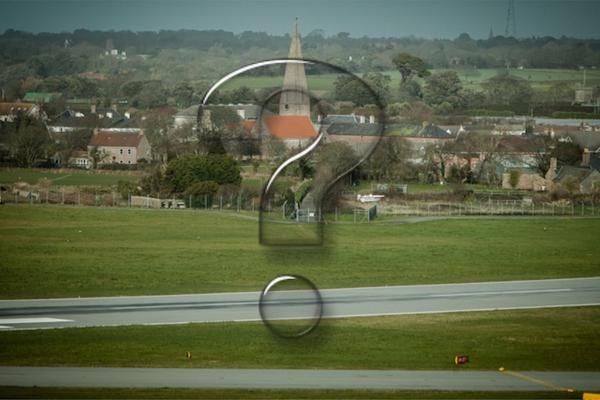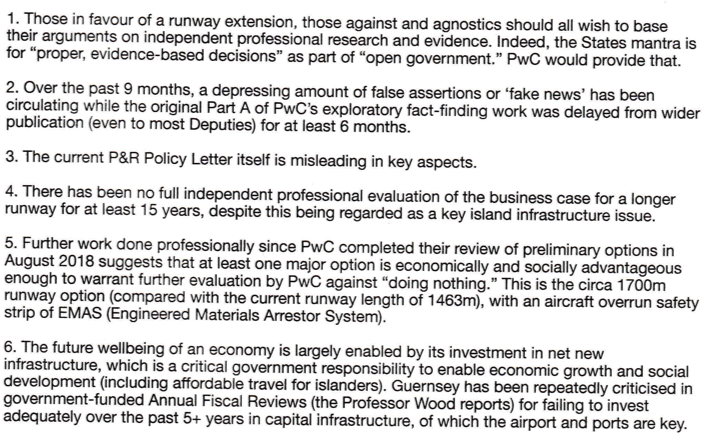

A non-voting member of STSB has spoken out against moves to stop any more work being done on a business plan for extending Guernsey's Runway.
John Hollis is on the States' Trading & Supervisory Board, and while he himself is not a Deputy, he sits alongside the three that are on the Board.
Mr Hollis penned an open letter last week criticising Policy & Resource's plans to halt PwC's efforts to create a report for the States outlining a business case on whether or not to extend the runway. This will all be decided in this month's States Meeting, which starts tomorrow, where P&R's policy letter to officially withdraw that funding will be debated.

Mr Hollis, second from right, is one of two non-voting members on the States' Trading & Supervisory Board.
Mr Hollis asked two key questions toward the end of his letter, calling on P&R to let the States be the 'business enabler' it needed to be. He said:
"Considering the strategic importance of improved air links to islanders and Guernsey's economy, are we really going to go a full polictical States term with no meaningful infrastructure investment decisions taken? Remember, spending $60million on new aircraft for Aurigny has nothing to do with any new air links policy.
"Is government prepared to act as the often quoted 'business enabler', or will it be deaf to business any any business cases?"
Then, in making the case for PwC to create its report, he listed six reasons why it was important for deputies to "finally have a proper professional business case evaluation for a longer runway, rather than continue to 'do nothing'". Those reasons are as follows:

The whole debate over whether or not to extend the runway has been ongoing for many years now, but at the end of last year when P&R came forward in December announcing it had decided to stop considering the matter, and recommended starting to withdraw funding from PwC's work on it, many were left surprised. The topic has since been a battleground of arguments on either side, with many in the island community still staunchly backing the idea of an extension, saying it could be the key to solving many of the travel problems Guernsey has.
And while P&R say this is, in their view, just not the case, Mr Hollis argues in his letter that surely the best way to decide is with a full set of objective facts. He compared public assertions to the P&R Policy Letter, and also reviewed why a BAE Systems study in 2003 and a York Aviation Study in 2008 had never came to anything.
"Both studies reinforce the reasons for evaluating runway options via a proper PwC business case in 2019," he said, "in 2008, York Aviation assessed aircraft types and related issues for the foreseeable future, quoting 10-15 years. Hence, it is now timely that the issues should be revisited 10 years later, given subsequent changes and a likely further five years to achieve change."
Ahead of tomorrow's debate on the runway, Mr Hollis raised eight questions surrounding whether the discussion had so far centred on the right things. Why, he asked, is a proper business case on a strategic priority being ended before it can be completed? To read the full eight questions, scroll to the bottom.
Mr Hollis concluded: "There is mounting evidence of financial business relocating or being deterred from coming to Guernsey due to relatively difficult or costly air links. Likewise visitors. Comparisons with Jersey are relevant. The difference in populations is not the key reason, as some would lazily claim. It is not a simple low price and low frequency trade-off - this was made very clear by Jersey's head of Ports & Airport. He emphasised that over 60% of air travellers to Jersey are visitors, and that without such volumes stimulated by low cost carriers, Jersey residents would have higher ticket costs and lower flight frequency.
"In recent years, P&R has done a good job with other States Committees in constructing spending to achieve a balance annual revenue budget or a small surplus. However, is [its] reluctance to spend any money on a proper, long overdue, professionalisms business case of runway extension options a disappointing example of a reluctance to invest adequate capital in island infrastructure for our future wellbeing?"
Policy & Resource's Policy Letter will be debated in the States meeting which starts tomorrow, Wedneday 24 April. The matter is expected to dominate the meeting.

Mr Hollis raised eight questions to consider before that States debate, they are as follows:
"Turning to the P&R Policy Letter released in March 2019 with the PwC Report Part A for debate in April, various questions arise, including:
1. How obvious is it that the appended PwC Report does not actually support the P&R conclusions and proposals in the P&R Policy Letter? Deputy Charles Parkinson, President of the Committee for Economic Development, speculated on BBC Radio many months ago that this might be the reason for its delayed publication from September 2018 until debate 7 months later in the States. He remains “agnostic on runway length until a professional evaluation and full business case is made”, believing that sound, evidence-based decision-making requires PwC to complete their intended work in Part B. Should not all Deputies take such a professional and principled approach?
2. Why is a proper business case on an acknowledged strategic priority such as air links being ended by non-funding before it can be completed? Is the claimed cost of “up to £700,000” actually realistic, given that there are only two or three major options to evaluate: 1463m (do nothing); 1570m (short-term reclassification fix, per Deputy Kuttelwascher, already being investigated by STSB for safety and other considerations); and 1700m+EMAS (proposed by experienced architect Rob Le Page in a recent letter to all deputies and the media)?
3. Is paragraph 5.39 of the Policy Letter positively misleading in stating “PwC’s recommendation is that 1570m appears to be the best runway option if it is feasible from a commercial and operational perspective for more than one airline”? The attached PwC Report does not “recommend” the 1570m extension for obvious reasons, including unresolved safety, regulatory and commercial uncertainties. The PwC Report actually recommends (on page 20) that “A 1700-1800m extension should be taken forward as the primary alternative to the 1570m option. There are clear additional benefits and it is lower risk in the longer term, although there may be a substantial cost difference.” The overriding recommendation of the PwC Report is that a proper business case evaluation of the costs, benefits and risks of the main options must be carried out in their proposed Part B of their work before any single option can be “recommended” (as Page 22 makes clear).
4. Why has so much advance publicity been associated with a 2000m runway (and “bulldozing part of St Peters”) when that is not even listed in the PwC Part A Report as a promising option to explore further in the proposed PwC Report Part B? Indeed, on Page 20 of their report, PwC reject it for further study.
5. Why does It incorrectly suggest in section 5.28 that an 1800m option is required to attract low cost carriers such as EasyJet? Both EasyJet and BA operate out of Jersey’s 1706m runway and both have indicated they only need 1700m in Guernsey. Interestingly, some have estimated the cost of an extension to 1700m as being half that of an extension to 1800m.
6. Why was there misleading advance publicity that “there is no business case for a runway extension”? Some would have heard this and believed a business case had been attempted by PwC but could not justify an extension. The published PwC Report Part A makes clear that no such business case has yet been attempted. It recommends that one is produced for the more promising options in Part B of their proposed work, but P&R are against providing any funding for this.
7. Why is there no explicit mention of a 1700m runway option plus EMAS runway overshoot safety facilities in the Policy Letter? Such an option would see the 1700m runway fit within the existing airport perimeter and the EMAS overshoot area take up only 50% of the area earmarked for the airport in the Island Development Plan (IDP) approved by the States in 2016. It also involves the loss of no existing houses or buildings, and leaves Le Blicqs untouched, as explained in February 2019 by local architect Rob Le Page with detailed plans to Deputies and the media. Is this another sign of premature curtailment of investigating options?
8. Why is there no mention of safety trade-offs associated with a minimalist runway (1463m or 1570m operating at regulatory safety limits for intended aircraft) relative to 1700m? Safety is not simply a ‘safe or unsafe’ issue here, but one of degrees of safety margins in varying conditions.
Should Guernsey allow ‘short-term accounting thinking’ to drive us towards operating only marginally within absolute safety limits in the longer term?"
Pictured top: Guernsey's current runway.
Comments
Comments on this story express the views of the commentator only, not Bailiwick Publishing. We are unable to guarantee the accuracy of any of those comments.